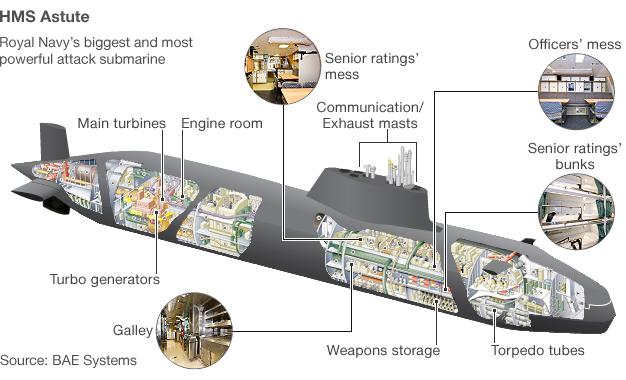HMS Astute recovers from shaky start
- Published
Lieutenant Commander Louis Bull explains how the modern periscope works
"Slow, leaky and rusty" was how a recent headline in the Guardian newspaper , externaldescribed the Royal Navy's latest £1.2bn attack submarine.
It's hard to deny that HMS Astute has so far hit the headlines for mostly the wrong reasons.
Early in its sea trials in 2010, Astute - the first of the Navy's brand new submarine class of the same name - ran aground off the Isle of Skye.
After colliding with a tug that had come to her rescue she had to go back for repairs.
And last year, whilst docked in Southampton on a "good will visit" a crew member shot dead an officer, Lieutenant Commander Ian Molyneux.
And then came the Guardian story that highlighted an alarming list of technical problems. They included corroded pipes, the wrong lead around the nuclear reactor, a flood caused by an incorrect fitting and questions about her speed. So it may be little surprise that some have started calling Astute "HMS Calamity" instead.
That might put some off, but when the Royal Navy invited me on board, as Astute conducted sea trials off the West Coast of Scotland, I'd have been a fool to say no. So far no journalist has seen her being put through her paces.
Two admirals were also on the visit to check for themselves whether the submarine was living up to the Royal Navy's high expectations - hardly able to contain their excitement at leaving the office for a few days.

One of them, Rear Admiral Simon Lister, is in charge of this complex programme, and as he took me round the cramped corridors, past the nuclear reactor and down into the sweaty machine rooms, he acknowledged this was a prototype and there was always going to be some "teething" issues.
He likens the submarine to a 7,000 tonne Swiss watch - emphasising "it works and it's safe".
While Admiral Lister admits flaws have been found, he insists it's only because he's looking for perfection.
Issues of quality assurance have been identified and rectified. He says it shows the system works. So the correct paint has been applied to those areas that have suffered corrosion, and a bolt with the right kind of metal has been attached to a fitting that earlier caused the "minor" flood.
One gets the impression from his visit that his work is not over. But it's worth remembering that this is the first attack submarine that British workers have built from scratch in nearly 40 years.
The skills needed to construct Astute, which some say is as complex as the space shuttle, had almost been lost for good.
On paper, at least, the Astute class is a significant step forward. It can carry more weapons - both spearfish torpedoes and Tomahawk land attack cruise missiles - than the earlier Trafalgar Class submarine.
It's the first Royal Navy submarine that can hover underwater.
The hover adds to its stealth. Chief Petty Officer Andy Horsburgh, whose job is utilising the submarine's sophisticated sonar, says that when at sea other submarines need to worry because "we'll find them before they find us". He adds that this is "what submarines are designed to do".
Classified features
Weapons engineer Sean Roddy on how crew member sleep alongside missiles
The one thing missed by Astute's captain, Commander Stephen Walker, is that he no longer has a traditional periscope to peer above the water.
Forget what you may have seen on Das Boot or the Hunt for Red October. Instead Astute has cameras fitted on a mast that feed live pictures into the control room. In daylight it provides colour images that can zoom into a target. At night they use a thermal imaging camera.
Unlike the old periscope that would pop out of the water for minutes at a time, Astute's mast breaks cover for just a few seconds. It can record what it sees giving the crew time to analyse the images. It's another feature that makes the submarine harder to detect.
There are some things, though, that the 100-plus crew, and the visiting admirals, appear less keen to discuss. Its speed for one, which I'm told is not an issue, but is classified.
Or the strange pod attached to the rear of the conning tower. It's believed to house a mini submarine used to "insert" special forces. It too is being tried and tested. But no one on board is allowed to mention the "Chalfont" hangar, even though it sticks out like a sore thumb when the submarine's surfaced.
Everyone is keen to address what they feel has been an unfair hearing by the press about the submarine. This is as much because it's created some anxiety for families back on shore.
The submarine's coxswain, Chief Petty Officer Warren Crew, says like anything new it's going to have some problems. But he still says Astute is a "massive advance" - and he's served on most of the Navy's older nuclear powered submarines.
To counter the crew's enthusiasm, it's worth considering some other facts. It's taken a decade to build HMS Astute. Five years after she was launched and more than two years after she was commissioned and she's still undergoing sea trials. The programme is way over budget and late.
The Royal Navy says Astute will be ready for her first deployment late next year. And the Ministry of Defence's confidence in the technology is reflected in the confirmation that it's spending another £1.2bn on a fourth submarine of her class.
The launch should be much quicker and easier now that snags have been sorted. And Admiral Lister will be hoping for fewer negative headlines about his prize boats.
- Published10 December 2012
- Published21 November 2012
- Published24 April 2012
- Published9 December 2012